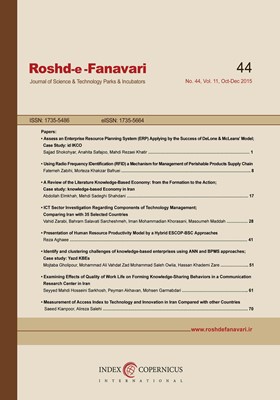Using Radio Frequency IDentification (RFID) a Mechanism for Management of Perishable Products Supply Chain
Subject Areas : Technology ManagementFatemeh Zabihi 1 , Morteza Khakzar Bafrue 2
1 -
2 - Tarbiat Modares University
Keywords: RFID, Perishable Goods, Pricing, Breakeven, Promotion Plan,
Abstract :
Radio Frequency Identification (RFID), a leading technology could be useful for reducing the supply chain food. The RFID can be effective with receiving product information and reducing costs. The greatest challenges are the supply chain management of perishable goods, especially the food. Variation in the number of goods, tracking and follow-up the flow of goods throughout the supply chain, low life expectancy, high volume products requiring temperature control in the supply chain is some of the challenges. The risk of food at each stage of the supply chain of food can occur, resulting in the definition of management to obtain information, ingredients, date of production (sales, consumption), etc., and provide it in a transparent manner to provide supply chain suppliers and consumers is necessary. One of the best possible solutions is using of RFID that help the supply chain management in perishable goods logistics. This paper examines the business model of the financial implementation of RFID in tracking food. To clarify the subject, a case study RFID system using in Taiwan welfare chain stores has been providing. In this case by introducing two upgrade projects 4 and 6 years old, profit and costs associated with the implementation of RFID for manufacturers, distributors and retailers in the supply chain of convenience stores have been analyzed.
1- S. Piramuthu, P. Farahani, and M. Grunow, "RFID-generated traceability for contaminated product recall in perishable food supply networks," European Journal of Operational Research, vol. 225, no. 2, pp. 253–262, 2013.#
2- S.O. Tromp, H. Rijgersberg, F.I.D.G. Pereira da Silva, and P.V. Bartels, "retail benefits of dynamic expiry dates – simulating opportunity losses due to product loss, discount policy and out of stock," International Journal of Production Economics, vol. 139, pp. 14–21, 2012.#
3- F. Tijun, T. Feng, D. Sheng, and L. Shuxia, "Impact of RFID technology on supply chain decisions with inventory inaccuracies," International Journal of Production Economics, vol. 159, pp. 117–125, 2015.#
4- D. Tanner, "Applications for RFID Technologies in the Food Supply Chain," Reference Module in Food Science, 2016.#
5- M.C. O'Connor, "Cold-chain project reveals temperature inconsistencies," RFID Journal http://www.rfidjournal.com/articles/view?2860, 2006.#
6- J.-P. Emond and M., Nicometo, "Shelf-life Prediction and FEFO Inventory Management with RFID," Cool Chain Association Workshop.Temperature Measurements When, Where and How? Knivsta,Sweden, 2006.#
7- K. Koutsoumanis, P.S. Taoukis, and G.J.E. Nychas, "Development of a safety monitoring and assurance system for chilled food products," International Journal of Food Microbiology, vol. 100, no. 1-3, pp. 253–260, 2005.#
8- R. Stockute, A. Veaux, and P. Johnson, "Paul Johnson Homepage," Logistic Distribution. Available from:, 2006.#
9- I.-H. Hong, J.-F. Dang, Y.-H. Tsai, C.-S. Liu, W.-T. Lee, M.-L. Wang and P.-C. Chen, "An RFID application in the food supply chain: A case study of convenience stores in Taiwan," Journal of Food Engineering, vol. 106, no. 2, pp. 119–126, 2011.#


